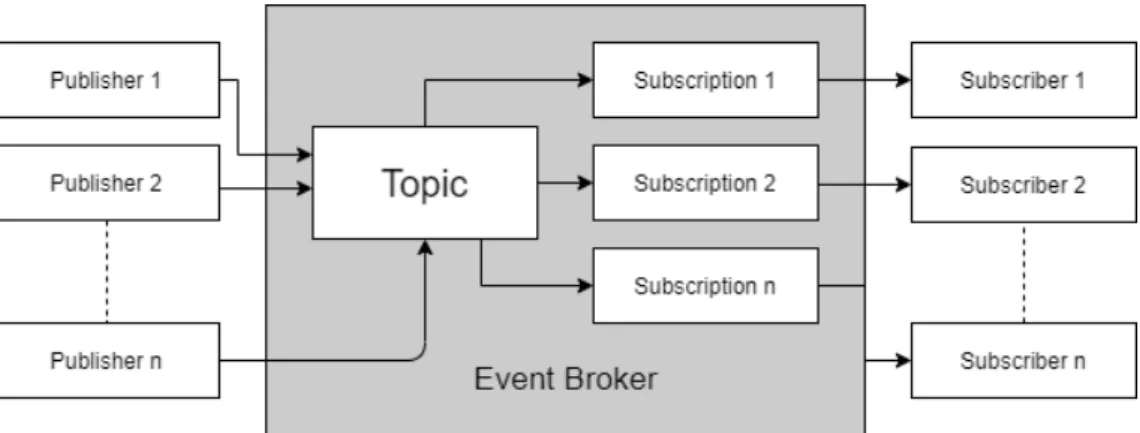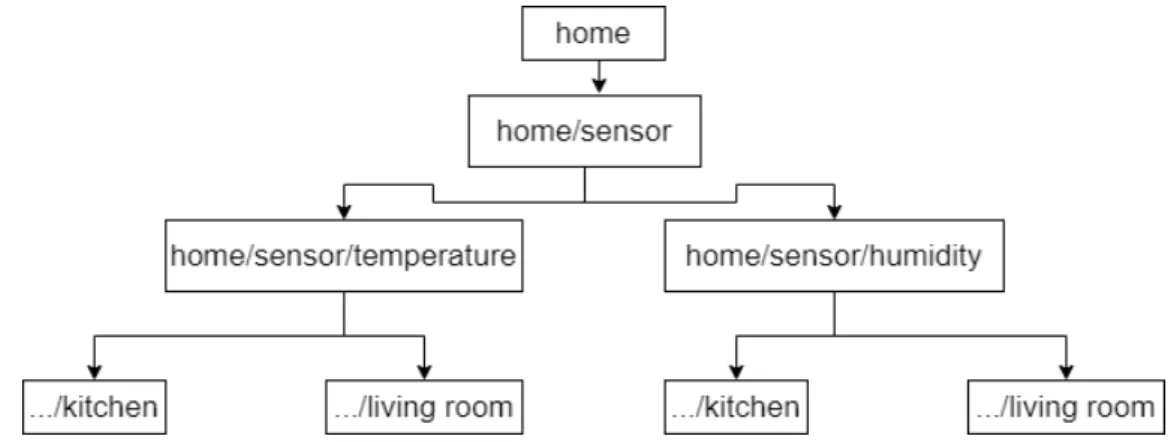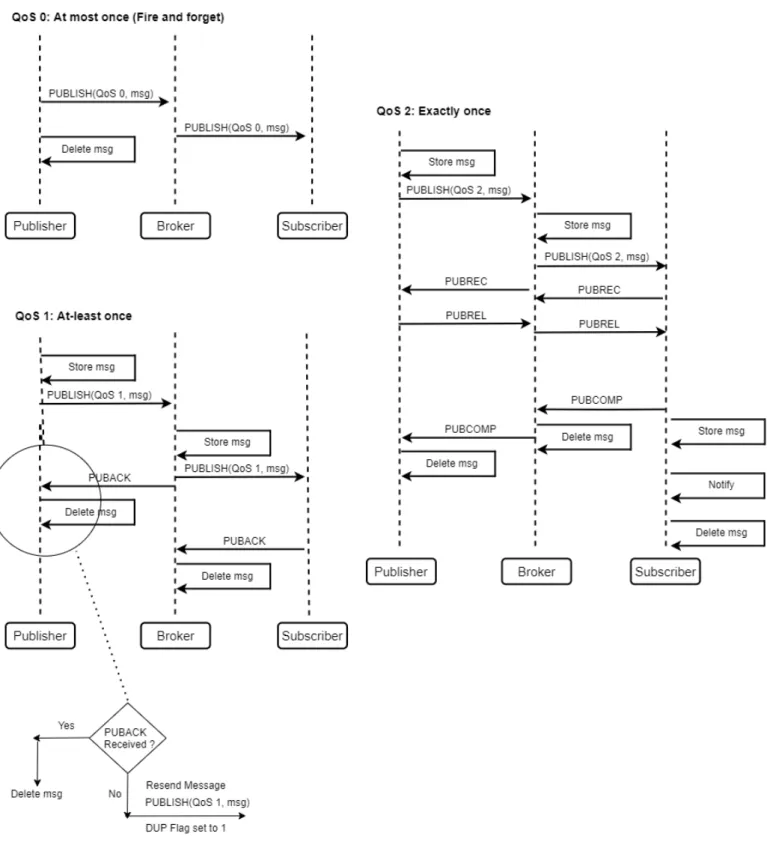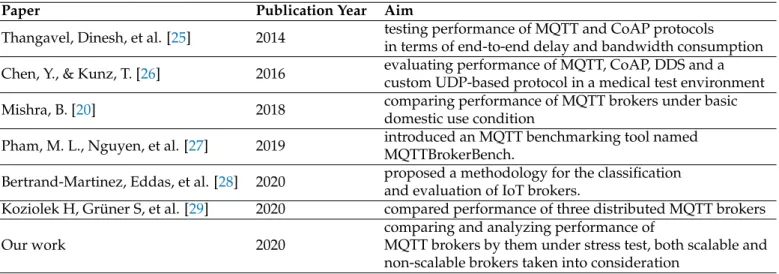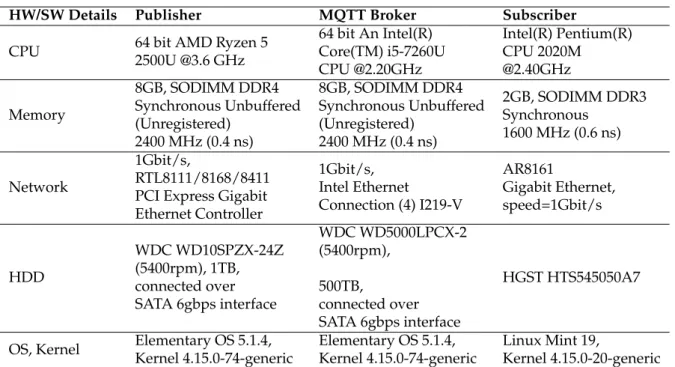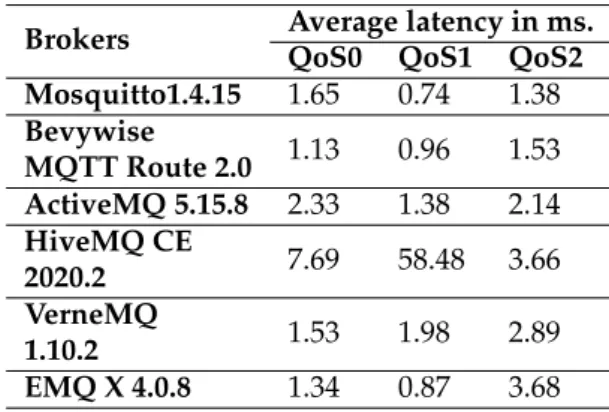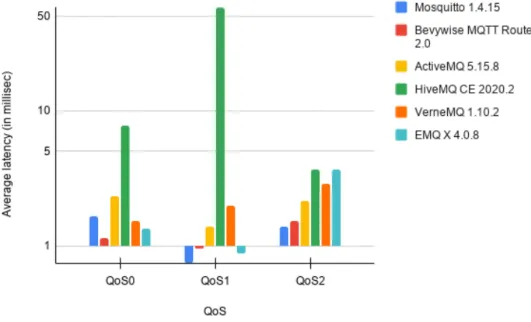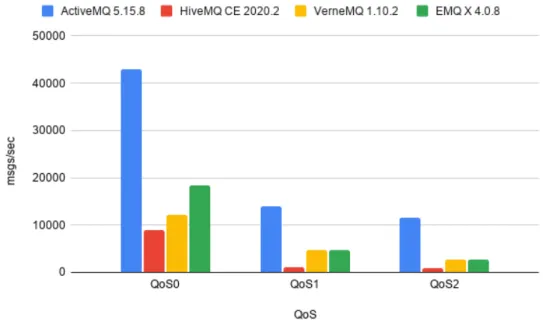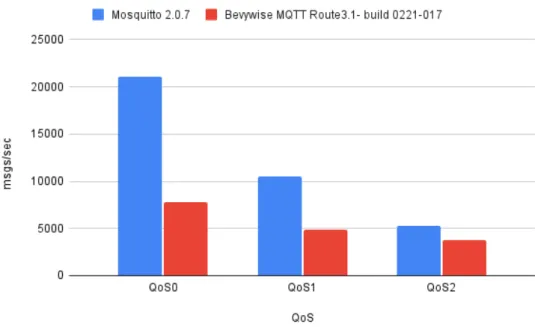Performance Measurements
Biswajeeban Mishra1,†,‡, *, Biswaranjan Mishra2,‡, and Attila Kertesz1,†,‡
Citation: Mishra, B.; Mishra, B.;
Kertesz, A. Title.Energies2021,1, 0.
https://doi.org/
Received:
Accepted:
Published:
Publisher’s Note: MDPI stays neu- tral with regard to jurisdictional claims in published maps and insti- tutional affiliations.
Copyright: © 2021 by the authors.
Submitted to Energies for possible open access publication under the terms and conditions of the Cre- ative Commons Attribution (CC BY) license (https://creativecom- mons.org/licenses/by/ 4.0/).
1 University of Szeged, Hungary - 6720; mishra@inf.u-szeged.hu, keratt@inf.u-szeged.hu
2 #34b, 5a cross, NRI Layout, Bengaluru, India - 560043; biswaranjan.mishra@live.com
* Correspondence: mishra@inf.u-szeged.hu
† Current address: Department of Software Engineering, University of Szeged, Szeged, Hungary - 6720
‡ These authors contributed equally to this work.
Abstract:Nowadays, Internet of Things (IoT) protocols are at the heart of Machine-to-Machine
1
(M2M) communication. Irrespective of the radio technologies used for deploying an IoT/M2M
2
network, all independent data generated by IoT devices (sensors and actuators) rely heavily on
3
the special messaging protocols used for M2M communication in IoT applications. As the demand
4
for IoT services is growing, the need for reduced power consumption of IoT devices and services
5
is also growing to ensure a sustainable environment for future generations. The Message Queuing
6
Telemetry Transport or in short MQTT is a widely used IoT protocol. It is a low resource consuming
7
messaging solution based on the publish-subscribe type communication model. This paper aims
8
to assess the performance of several MQTT Broker implementations (also called as MQTT Servers)
9
using stress testing, and to analyze their relationship with system design. The evaluation of the
10
brokers is performed by a realistic test scenario, and the analysis of the test results is done with
11
three different metrics: CPU usage, latency, and message rate. As the main contribution of this
12
work, we analyzed six MQTT brokers (Mosquitto, Active-MQ, Hivemq, Bevywise, VerneMQ,
13
and EMQ X) in detail, and classified them using their main properties. Our results showed that
14
Mosquitto outperforms the other considered solutions in most metrics, however, ActiveMQ is
15
the best performing one in terms of scalability due to its multi-threaded implementation, while
16
Bevywise has promising results for resource-constrained scenarios.
17
Keywords:Internet of Things; Messaging Protocol; MQTT; MQTT Brokers; Performance Evalua-
18
tion; Stress testing
19
1. Introduction
20
In recent times, as the cost of sensors and actuators is continuing to fall, the number
21
of Internet of Things (IoT) devices is rapidly growing and becoming parts of our lives.
22
As a result, the IoT footprint is significantly noticeable everywhere. It is hard to find any
23
industry that does not get revolutionized with the advent of this promising technology.
24
A recent report [1] states that there would be around 125 billion IoT devices connected
25
to the Internet by 2030. IoT networks use several radio technologies such as WLAN,
26
WPAN, etc. for communication at a lower layer. Regardless of the radio technology used,
27
to create an M2M network, the end device or machine (IoT device) must make their data
28
accessible through the Internet [2,3]. IoT devices are usually resource-constrained. It
29
means that they operate with limited computation, memory, storage, energy storage
30
(battery), and networking capabilities [4], [6]. Hence, the efficiency of M2M communica-
31
tions largely depends on the underlying special messaging protocols designed for M2M
32
communication in IoT applications. MQTT (Message Queuing Telemetry Transport)
33
[5], CoAP (Constrained Application Protocol), AMQP (Advanced Message Queuing
34
Protocol), and HTTP (Hypertext Transfer Protocol) are the few to name in the M2M
35
Communication Protocol segment [4,6]. Among these IoT Protocols, MQTT is a free,
36
Version September 8, 2021 submitted toEnergies https://www.mdpi.com/journal/energies
simple to deploy, lightweight, and energy-efficient application layer protocol. These
37
properties make MQTT an ideal communication solution for IoT systems [8–10]. As
38
Green Computing primarily focuses on implementing energy-saving technologies that
39
help reduce the greenhouse impact on the environment [11], ideal design and imple-
40
mentation of MQTT based solutions can be immensely helpful in realizing the goals of a
41
sustainable future. MQTT is a topic-based publish/subscribe type protocol that runs on
42
TCP/IP using ports 1883 and 8883 for non-encrypted and encrypted communication,
43
respectively. There are two types of network entities in the MQTT protocol: a message
44
broker, also called as the server, and the client, which actually play publisher and sub-
45
scriber roles). A publisher sends messages with a topic head to a server, then it delivers
46
the messages to the subscribers listening that topic [8]. Currently, we have many MQTT
47
based broker (server) distributions available in the market from various vendors.
48
Our main goal in this research is to answer the following question: How does a
49
scalable or a non-scalable broker implementation perform in a single-core and multi-core CPU
50
test-bed, when it is put under stress-conditions? The main contribution of this work is
51
analyzing and comparing the performance of considered scalable and non-scalable
52
brokers based on the following metrics: maximum message rate, average process CPU
53
Usage in percentage at maximum message rate, normalized message rate at 100% CPU
54
usage, and average latency. This work is a revised and significantly extended version
55
of the short paper [12]. It highlights the relationship of a MQTT broker system design
56
and its performance under stress-testing. The MQTT protocol has many application
57
areas such as healthcare, logistics, smart city services etc [13]. Each application area has
58
a different set of MQTT-based requirements. In this experiment, we are not evaluating
59
MQTT brokers against those specific set of requirements rather we are conducting a
60
system test of MQTT servers to analyze their message handling capability, the robustness
61
of implementation, and efficient resource utilization potential. To achieve this, we send
62
a high volume of short messages (low payload) with a limited set of publishers and
63
subscribers.
64
The remainder of this paper is organized as follows. Section2introduces back-
65
ground of this study. Section 3summarizes some notable related works. Section4
66
describes the test environment, evaluation parameters and test results in detail. In
67
Section5, we discuss the evaluation results, and finally, with Section6we conclude the
68
paper.
69
2. Background
70
2.1. Basics of a publish/subscribe Messaging Service
71
These are the terms we often come across while working with a publish/subscribe
72
or Pub/Sub System. "Message" refers to the data that flows through the system. "Topic"
73
is an object that presents a message stream. "Publisher" creates messages and sends them
74
to the messaging service on a particular Topic head. The act of sending messages to the
75
messaging service is called "Publishing". A publisher is also referred to as a Producer.
76
"Subscriber", otherwise known as "Consumer", receives the messages on a specific sub-
77
scription. "Subscription" refers to an interest in receiving messages on a particular topic.
78
In a Pub/Sub system, producers of the event-driven data are usually decoupled from
79
the consumers of the data [14,15]: meaning publishers and subscribers are independent
80
components that share information by publishing event-driven messages and by sub-
81
scribing to event-driven messages of choice [14]. The central component of this system
82
is called an event broker. It keeps a record of all the subscriptions. A publisher usually
83
sends a message to the Event broker on a specific topic head and then the event broker
84
sends it to all the subscribers that previously subscribed to that topic. The event broker
85
basically acts as a postmaster to match, notify, and deliver events to the corresponding
86
subscribers. Fig.1describes the overall architecture of a Pub/Sub system [16].
87
Figure 1.Overall architecture of a Pub/Sub system 2.2. Overview of MQTT Architecture
88
MQTT is a simple, lightweight, TCP/IP based Pub/Sub type messaging protocol
89
[11]. MQTT supports one-to-many, two-way, asynchronous communication [7]. Having
90
a binary header makes MQTT a lightweight protocol to carry telemetry data transmission
91
between constraint devices [17,18] over unreliable networks [19]. It has three constituent
92
components:
93
• A Publisher or Producer (An MQTT client).
94
• A Broker (An MQTT server).
95
• A Consumer or Subscriber (An MQTT client).
96
In MQTT, a client that is responsible for opening a network connection, creating
97
and sending messages to the server is called a publisher. The subscriber is a client that
98
subscribes to a topic of interest in advance in order to receive messages. It can also
99
unsubscribe from a topic in order to delete a request for application messages and close
100
network connection to the server [20] as needed. The server is otherwise known as a
101
broker acts as a post office between the publisher and the subscriber. It receives messages
102
from the publishers and forwards them to all the subscribers. Fig. 2presents a basic
103
model of MQTT [21].
104
Figure 2.MQTT Components: Publisher, MQTT Broker, and Subscriber.
Any application message carried by the MQTT protocol across the network to
105
its destination contains a quality of service (QoS), payload data, a topic name [22],
106
and a collection of properties. An application message can carry a payload up to
107
the maximum size of 256 MB [3]. A topic is usually a label attached to all messages.
108
Topic names are UTF-8 encoded strings and can be freely chosen [22]. Topic names
109
can represent a multilevel hierarchy of information using a forward slash (/). For ex-
110
ample, this topic name can represent a humidity sensor in the kitchen room: "home/
111
sensor/humidity/kitchen". We can have other topic names for other sensors that are
112
present in other rooms: "home/sensor/temperature/livingroom", and "home/ sen-
113
sor/temperature/kitchen" etc. Fig.3shows an example of a topic tree.
114
Figure 3.Topic tree hierarchy.
MQTT offers three types of QoS (Quality of Service) levels to send messages to an
115
MQTT Broker or a client. It ranges from 0 to 2, see Fig. 4. By using QoS level 0: the
116
sender does not store the message, and the received does not acknowledge its receiving.
117
This method requires only one message and once the message is sent to the broker by
118
the client it gets deleted from the message queue. Therefore QoS 0 nullifies the chances
119
of duplicate messages, that is why it is also called as the "fire and forget" method. It
120
provides a minimal and most unreliable message transmission level that offers the fastest
121
delivery effort. Using QoS 1, the delivery of a message is guaranteed (at least once, but
122
the message may be sent more than once , if necessary). This method needs two messages.
123
Here, the sender sends a message and waits to receive an acknowledgment (PUBACK
124
message) to receive. If it receives an acknowledgment from the client then it deletes
125
the message from the outward-bound queue. In case, it does not receive a PUBACK
126
message, it resends the message with the duplicate flag (DUP flag) enabled. The QoS 2
127
level setting guarantees exactly-once delivery of a message. This is the slowest of all the
128
levels and needs four messages. In this level, the sender sends a message and waits for
129
an acknowledgment (PUBREC message). The receiver also sends a PUBREC message. If
130
the sender of the message fails to receive an acknowledgment (PUBREC), it sends the
131
message again with the DUP flag enabled. Upon receiving the acknowledgment message
132
PUBREC, the sender transmits the message release message (PUBREL). If the receiver
133
does not get the PUBREL message it resends the PUBREC message. Once the receiver
134
receives the PUBREL message, It forwards the message to all the subscribing clients.
135
Thereafter the receiver sends a publish complete (PUBCOMP) message. In case the
136
sender does not get the PUBCOMP message, it resends the PUBREL message. Once the
137
sending client receives the PUBCOMP message, the transmission process gets marked
138
as completed and the message can be deleted from the outbound queue [13].
139
2.3. Scalability and types of MQTT Broker Implementations
140
System scalability can be defined as the ability to expand to meet increasing work-
141
load [23]. Scalability enhancement of any message broker depends on two prime factors;
142
the first one is to enhance a single system performance, while the second one is to
143
use clustering. In case of an MQTT message broker deployment, the performance of
144
an MQTT broker using a single system can be improved by using event-driven I/O
145
mechanism for the CPU cores during dispatching TCP connections from MQTT clients
146
[22]. The other way of achieving better scalability is clustering, when an MQTT broker
147
cluster is used in a distributed fashion. In this case it seems to be a single logical broker
148
for the user, but in reality, multiple physical MQTT brokers share the same workload
149
[24].
150
Figure 4.Different QoS levels.
There are two types of message broker implementations: single or fixed number of
151
threads non-scalable broker implementations and multi-thread or multi-process scalable
152
broker implementations that can efficiently utilize all available resources in a system [16].
153
For example, Mosquitto and Bevywise MQTT Route are non-scalable broker implementa-
154
tions that cannot utilize all system resources, and broker implementations like ActiveMQ,
155
HiveMQ, VerneMQ, and EMQ X are scalable [24]. It is be noted that Mosquitto provides
156
a "bridge mode" that can be used to form a cluster of message brokers. In this mode,
157
multiple cores get utilized according to the number of Mosquitto processes running
158
in the cluster. However, the drawback of this mode is the communication overhead
159
between the processes inside the cluster results in the poorer overall performance of the
160
system [16].
161
2.4. Evaluating the Performance of a Messaging Service
162
Google in its "Cloud Pub/Sub" product guide [14] nicely narrates the parameters
163
to judge the performance of any publish/subscribe type messaging service. The per-
164
formance of a publish/subscribe type messaging services can be measured in three
165
factors "latency", "scalability", and "availability". However, these three aspects frequently
166
contradict each other and involve compromises on one to boost the other two. The fol-
167
lowing paragraphs put some light on these terms in a pub/sub type messaging service
168
prospective.
169
2.4.1. Latency
170
Latency is a time-based metric for evaluating the performance of a system. A good
171
messaging service has to optimize and reduce latency, wherever it is possible. The
172
latency metric can be defined for a publish/subscribe service in the following: it denotes
173
the time the service takes to acknowledge a sent message, or the time the service takes to
174
send a published message to its subscriber. Latency can also be defined as the time taken
175
by a messaging service to send a message from the publisher to the subscriber [14].
176
2.4.2. Scalability
177
Scalability usually refers to the ability to scale up with the increase in load. A robust
178
scalable service can handle the increased load without an observable change in latency
179
or availability. One can define load in a publish/subscribe type service by referring to
180
the number of topics, publishers, subscribers, subscriptions or messages, as well as to
181
the size of messages or the payload, and to the rate of sent messages, called throughput
182
[14].
183
2.4.3. Availability
184
Systems can fail. It has many reasons. It may occur due to a human error while
185
building or deploying software or configurations or it may be caused due to hardware
186
failures such as disk drives malfunctioning or network connectivity issues. Sometimes a
187
sudden increase in load results in resource shortage and thus causes a system failure.
188
When we say "sound availability of a system" - it usually refers to the ability of the
189
system to handle a different type of failure in such a manner that is unobservable at the
190
customer’s end [14].
191
3. Related Work
192
There have been numerous works around the performance evaluation of various
193
IoT communication protocols. In this section, we briefly summarize some of the no-
194
table works published in recent years. Table1presents a comparison of related works
195
according to their main contributions.
196
In 2014, Thangavel, Dinesh, et al. [25], conducted multiple experiments using a
197
common middleware, to test MQTT and CoAP protocols, bandwidth consumption and
198
end-to-end delay. Their results showed that using CoAP messages showed higher delay
199
and packet loss rates than using MQTT messages.
200
Chen, Y., and Kunz, T., in 2016 [26], evaluated in a medical test environment MQTT,
201
CoAP, and DDS (Data Distribution Service) performance, compared to a custom, UDP-
202
based protocol. They used a network emulator, and their findings showed that DDS
203
consumes higher bandwidth than MQTT, but it performs significantly better for data
204
latency and reliability. DDS and MQTT, being TCP-based protocols, produced zero
205
packet loss under degraded network conditions. The custom UDP and UDP-based
206
CoAP showed significant data loss under similar test conditions.
207
Mishra, B., in 2019 [20], investigated the performance of several public and locally
208
deployed MQTT brokers, in terms of subscription throughput. The performance of
209
MQTT brokers was analyzed under normal and stressed conditions. The test results
210
showed that there is an insignificant difference between the performance of several
211
MQTT brokers in normal deployment cases, but the performance of various MQTT
212
brokers significantly varied from each other under the stressed conditions.
213
Pham, M. L., Nguyen, et al., in 2019 [27], introduced an MQTT benchmarking tool
214
named MQTTBrokerBench. The tool is useful to analyze the performance of MQTT
215
brokers by manually specifying load saturation points for the brokers.
216
Bertrand-Martinez, Eddas, et al [28], in 2020, proposed a method for the classi-
217
fication and evaluation of IoT brokers. They performed qualitative evaluation using
218
the ISO/IEC 25000 (SQuaRE) set of standards and the Jain’s process for performance
219
evaluation. The authors have validated the feasibility of their methodological approach
220
with a case study on 12 different open source brokers.
221
Koziolek H, Grüner S, et al. [29], in 2020 compared three distributed MQTT brokers
222
in terms of scalability, performance, extensibility, resilience, usability, and security. In
223
their edge gateway, the cluster-based test scenario showed that EMQX had the best
224
performance, while HiveMQ showed no message loss, while VerneMQ managed to
225
deliver up to 10K msg/s, respectively. The authors also proposed six decision points to
226
be taken into account by software architects for deploying MQTT brokers.
227
Referring back to this work of ours, we compare both scalable and non-scalable
228
MQTT brokers and analyze the performance of six MQTT brokers in terms of message
229
processing rate at 100% process/system CPU utilization, normalized message rate at
230
unrestricted resource (CPU) usage, and average latency. We also analyze how each
231
broker performs in a single-core and multi-core processor environment. For a better
232
analysis of the performances of MQTT brokers, we conducted this experiment in a
233
low-end local testing environment as well as in a comparatively high-end cloud-based
234
testing environment. This experiment deals with an important problem of the relation
235
of MQTT broker system design and its performance under stress testing. Although
236
It is a well-known fact that modular systems better perform on scalable and elastic
237
requirements but we lack experiment-based information about that relationship. So,
238
results obtained in this study would be immensely helpful to developers of real-time
239
systems and services.
240
4. Local and Cloud Test Environment Settings and Benchmarking Results
241
This section presents the setup of our realistic testbed in detail. To conduct stress
242
tests on various MQTT Brokers, we have built two emulated IoT environments:
243
• one is a local testing environment, and
244
• the other one is a cloud-based testing environment.
245
The local testbed was created using an Intel NUC (NUC7i5BNB), a Toshiba Satellite
246
B40-A laptop PC, and an Ideapad 330-15ARR laptop PC. To diminish network bottle-
247
neck issues, the devices were connected through a Gigabit Ethernet switch. The Intel
248
NUC7i5BNB was configured as a server running an MQTT Broker, the Ideapad 330-
249
15ARR laptop was used as a publisher machine, and the Toshiba, Satellite B40-A was
250
used as a subscriber machine. The Ideapad 330-15ARR (publisher machine), with 8
251
hardware threads, is capable enough of firing messages at higher rates. Table2presents
252
a summary of the specifications of the hardware and software used to build our local
253
evaluation environment.
254
The cloud testbed was configured on Google Cloud Platform (GCP) [30]. We created
255
three c2-standard-8 virtual machine (VM) instances that are having 8 vCPUs, 32 GB of
256
memory, and 30 GB local SSD each to act as publisher, subscriber, and server respectively.
257
All the VM instances are placed within a Virtual Private Cloud (VPC) Network subnet
258
using Google’s high-performing premium tier network service [31]. Table3presents a
259
summary of the specifications of our cloud test environment [32].
260
Table 1: Comparison of related works according to their main contributions.
Paper Publication Year Aim
Thangavel, Dinesh, et al. [25] 2014 testing performance of MQTT and CoAP protocols in terms of end-to-end delay and bandwidth consumption Chen, Y., & Kunz, T. [26] 2016 evaluating performance of MQTT, CoAP, DDS and a
custom UDP-based protocol in a medical test environment
Mishra, B. [20] 2018 comparing performance of MQTT brokers under basic
domestic use condition
Pham, M. L., Nguyen, et al. [27] 2019 introduced an MQTT benchmarking tool named MQTTBrokerBench.
Bertrand-Martinez, Eddas, et al. [28] 2020 proposed a methodology for the classification and evaluation of IoT brokers.
Koziolek H, Grüner S, et al. [29] 2020 compared performance of three distributed MQTT brokers
Our work 2020
comparing and analyzing performance of
MQTT brokers by them under stress test, both scalable and non-scalable brokers taken into consideration
In this experiment we used a higher message publishing rate with multiple pub-
261
lishers, and the overall CPU usage we experienced stayed below 70% on the publisher
262
machine. On the other hand, we also noticed that CPU usage on the subscriber side did
263
not exceed 80%. We experienced no swap usage at the subscriber, broker or publisher
264
machines during the evaluation.
265
For this experiment, we have developed a Paho Python MQTT library [33] based
266
benchmarking tool called MQTT Blaster [34] from scratch to send messages at very high
267
rates to the MQTT server from the publisher machine. The subscriber machine used the
268
"mosquitto_sub" command line subscribers, which is an MQTT client for subscribing
269
to topics and printing the received messages. During this empirical evaluation, the
270
"mosquitto_sub" output was redirected to the null device (/dev/null). In this way we
271
could ensure that resources are not consumed to write messages, and each subscriber
272
was configured to subscribe to the available published topics. In this way we made the
273
server reaching its threshold at reasonable message publishing rates. Fig.5presents the
274
evaluation environment topology.
275
Figure 5.The evaluation environment topology.
4.1. Evaluation Scenario
276
This experiment was conducted on four widely used scalable and two non-scalable
277
MQTT broker implementations. The other criteria for the selection of brokers were
278
ease of availability and configurability. The tested brokers are: "Mosquitto 1.4.15" [35],
279
"Bevywise MQTT Route 2.0" [36], "ActiveMQ 5.15.8" [37], "HiveMQ CE 2020.2" [38],
280
"VerneMQ 1.10.2" [39] and "EMQ X 4.0.8" [40]. Out of these MQTT brokers, Mosquitto
281
and Bevywise MQTT Route are non-scalable implementations, and the rest are scalable
282
in nature. It is to be mentioned that Mosquitto is a single-threaded implementation, and
283
Bevywise MQTT Route uses a dual thread approach, in which the first thread acts as
284
an initiator of the second that processes messages. Table4presents an overview of the
285
brokers.
286
Table 2: Hardware and software details of the local testing environment.
HW/SW Details Publisher MQTT Broker Subscriber
CPU 64 bit AMD Ryzen 5
2500U @3.6 GHz
64 bit An Intel(R) Core(TM) i5-7260U CPU @2.20GHz
Intel(R) Pentium(R) CPU 2020M
@2.40GHz
Memory
8GB, SODIMM DDR4 Synchronous Unbuffered (Unregistered)
2400 MHz (0.4 ns)
8GB, SODIMM DDR4 Synchronous Unbuffered (Unregistered)
2400 MHz (0.4 ns)
2GB, SODIMM DDR3 Synchronous
1600 MHz (0.6 ns)
Network
1Gbit/s,
RTL8111/8168/8411 PCI Express Gigabit Ethernet Controller
1Gbit/s, Intel Ethernet
Connection (4) I219-V
AR8161
Gigabit Ethernet, speed=1Gbit/s
HDD
WDC WD10SPZX-24Z (5400rpm), 1TB, connected over SATA 6gbps interface
WDC WD5000LPCX-2 (5400rpm),
500TB,
connected over SATA 6gbps interface
HGST HTS545050A7
OS, Kernel Elementary OS 5.1.4, Kernel 4.15.0-74-generic
Elementary OS 5.1.4, Kernel 4.15.0-74-generic
Linux Mint 19,
Kernel 4.15.0-20-generic Table 4: A bird’s-eye view of the tested brokers.
MQTT Brokers Mosquitto Bevywise MQTT Route ActiveMQ HiveMQ CE VerneMQ EMQ X
OpenSource Yes No Yes Yes Yes Yes
Written in
(prime programming language) C C, Python Java Java Erlang Erlang
MQTT Version 3.1.1, 5.0 3.x, 5.0 3.1 3.x, 5.1 3.x, 5.0 3.1.1
QoS Support 0, 1, 2 0, 1, 2 0, 1, 2 0, 1, 2 0, 1, 2 0, 1, 2
Operating System Support
Linux, Mac, Windows
Windows, Windows server, Linux, Mac and Raspberry Pi
Windows, Unix/
Linux/Cygwin
Linux, Mac, Windows
Linux, Mac OS X
Linux, Mac, Windows, BSD
Table 3: Hardware and software details of the cloud testing environment.
HW/SW details Publisher/Subscriber/Server Machine type c2-standard-8 [30]
CPU 8 vCPUs
Memory 32 GB
Disk size local 30 GB SSD
Disk type Standard persistent disk Network Tier Premium
OS, Kernel 18.04.1-Ubuntu SMP x86_64 GNU/Linux, 5.4.0-1038-gcp
4.1.1. Evaluation conditions
287
All the brokers were configured to run on these test conditions, see Table5, without
288
authentication method enabled and RETAIN flag set to true. It is to be noted that with
289
increase in the number of subscribers or the number of topics or message rate results
290
in an increased load on the broker. In our test environment, with the combination of
291
3 different publishing threads (1 topic per thread) and 15 subscribers, we were able
292
to push the broker to 100% process usage and limit the CPU usage on publisher and
293
subscriber machines below 70% and 80% respectively.
294
Table 5: Test conditions for the experiment.
Number of topics: 3
(via 3 publishers threads) Number of publishers: 3
Number of subscribers: 15 (subscribing to all 3 topics)
Payload: 64 bytes
Topic names used to publish large number of messages:
’topic/0’, ’topic/1’, ’topic/2’
Topic used to
calculate latency ’topic/latency’
4.1.2. Latency Calculations
295
Latency is defined as the time taken by a system to transmit a message from a
296
publisher to a subscriber [13]. This experiment tries to simulate a realistic scenario of a
297
client trying to publish a message, when the broker is overloaded with a large number
298
of messages on various topics from different clients. To achieve this, a different topic
299
was used to send messages for latency calculations from the topics on which messages
300
were fired to overload the system. It is noteworthy that an ideal broker implementation
301
should always be able to efficiently process messages irrespective of the rate of messages
302
fired to it.
303
4.1.3. Message Payload
304
By using the MQTT protocol, all messages are transferred using a single telemetry
305
parameter [9]. Baring this in mind, we utilized a small payload size not to overload the
306
server memory. Concerning the message payload size setting, we used 64 bytes for the
307
entire testing.
308
4.2. Benchmarking Results
309
We separate our experimental results into three distinct segments for better inter-
310
pretation and understanding. We had taken 3 samples for each QoS in each segment and
311
the best result with the maximum rate of message delivery, and zero message drop was
312
considered for comparison. The three different categories are:
313
1. Projected message processing rates of non-scalable brokers at 100% process CPU
314
usage. See Table6,9.
315
2. Projected message processing rates of scalable brokers at 100% system CPU usage.
316
See Table7,10.
317
3. Latency comparison of all the brokers (both scalable and non-scalable brokers) –
318
see Table8,11.
319
Table 8: Latency comparison of all the brokers in local test environment.
Brokers Average latency in ms.
QoS0 QoS1 QoS2 Mosquitto1.4.15 1.65 0.74 1.38 Bevywise
MQTT Route 2.0 1.13 0.96 1.53 ActiveMQ 5.15.8 2.33 1.38 2.14 HiveMQ CE
2020.2 7.69 58.48 3.66
VerneMQ
1.10.2 1.53 1.98 2.89
EMQ X 4.0.8 1.34 0.87 3.68
Table 6: Projected message processing rates of non-scalable brokers at 100% process CPU usage (local test results).
QoS QoS0 QoS1 QoS2
Observations/Broker (non-scalable) Mosquitto 1.4.15
Bevywise MQTT Route 2.0
Mosquitto 1.4.15
Bevywise MQTT Route 2.0
Mosquitto 1.4.15
Bevywise MQTT Route 2.0 Peak message rate (msgs/sec) 32016.00 32839.00 9488.00 3542.49 6585.00 2649.00
Average process CPU usage(%)
at above message rate 84.29 97.93 89.00 95.79 96.73 98.20
Projected message processing rate
at 100% process CPU usage 37983.15 33533.14 10660.67 3698.18 6807.61 2697.56
Average latency (in ms) 1.65 1.13 0.74 0.96 1.38 1.53
Important note* Mosquitto and Bevywise are fixed thread/single thread broker implementations. They cannot scale up to utilize all cores available in the system.
Table 7: Projected message processing rates of scalable brokers at 100% system CPU usage (local test results).
QoS QoS0 QoS1 QoS2
Observations/Broker (scalable) ActiveMQ 5.15.8
HiveMQ CE 2020.2
VerneMQ 1.10.2
EMQ X 4.0.8
ActiveMQ 5.15.8
HiveMQ CE 2020.2
VerneMQ 1.10.2
EMQ X 4.0.8
ActiveMQ 5.15.8
HiveMQ CE 2020.2
VerneMQ 1.10.2
EMQ X 4.0.8 Peak message rate (msgs/sec) 39479.00 8748.00 11760.00 18034.00 12873.00 708.00 4655.00 4633.41 10508.00 579.00 2614.00 2627.31 Average system CPU usage(%)
at above message rate 91.78 97.93 96.51 98.71 92.56 63.44 97.34 96.82 90.91 64.28 96.79 95.54
Projected message processing rate
at 100% system CPU usage 43014.82 8932.91 12185.27 18269.68 13907.74 1116.02 4782.21 4785.59 11558.68 900.75 2700.69 2749.96
Average latency (in ms) 2.33 7.69 1.53 1.34 1.38 58.48 1.98 0.87 2.14 3.66 2.89 3.68
Important note* All the brokers listed in this table are scalable in nature and can utilize all cores available in the system.
5. Discussion
320
5.1. Local evaluation results
321
In Table6, we present a comparative performance analysis of non-scalable MQTT
322
brokers. For non-scalable brokers like Mosquitto and Bevywise MQTT Route, the
323
projected message rate at 100% CPU usage (Rns) can be calculated with the below
324
Equation1:
325
Rns= Peak Message rate
Average Process CPU Usage∗100 (1)
Note:The CPU usage of a process (process CPU usage) is a measure of how much (in percentage)
326
of the CPU’s cycles are committed to the process that is currently running. Average process
327
CPU utilization indicates the observed average of CPU utilization by the process during the
328
experiment [41].
329
In this segment, Mosquitto 1.4.15 beats Bevywise MQTT Route 2.0 in terms of
330
projected message processing rate at approximately 100% process CPU usage across all
331
the QoS categories. See Figure6.
332
It is to be mentioned that being non-scalable Mosquitto and Bevywise MQTT Route
333
cannot make use of all available cores on the system. In terms of average latency (round
334
trip time), we found that at QoS0 Bevywise MQTT Route 2.0 leads the race, while in
335
all other QoS categories (QoS1 and QoS2), Mosquitto 1.4.15 occupies the top spot. See
336
Figure7.
337
Table7shows the benchmarking results of scalable broker implementations. In
338
this comparison, ActiveMQ 5.15.8 beats all other broker implementations (HiveMQ
339
CE 2020.2, VerneMQ 1.10.2, EMQ X 4.0.8) in terms of "average latency" across all QoS
340
categories. See Figure7.
341
In a multi-core or distributed environment, a scalable broker implementation
342
would scale up to utilize the maximum system resources available. Hence, the CPU
343
utilization data sum up the CPU utilization by the process group consisting of all sub-
344
processes/threads. The process group CPU utilization for scalable brokers can reach
345
up to 100*n% (where n = the number of cores available in the system). Here, in this
346
test environment as n = 4, the CPU utilization percent for the deployed brokers could
347
go up to 400%. This comparison gives a fair idea of how various brokers scale up and
348
Figure 6.Projected message rate (msgs/sec) of non-scalable brokers at ˜100% process CPU usage in the local evaluation environment.
Figure 7. A comparison of average latency of all scalable and non-scalable brokers in the local evaluation environment.
perform when they are deployed on a multi-core set-up. For scalable brokers, Equation
349
2calculates the projected message rate at the unrestricted resource (CPU) (Rs):
350
Rs = Peak Message rate
Average System CPU Usage∗100 (2)
Note:System CPU usage refers to how the available processors whether real or virtual in
351
a System are being utilized. Average System CPU usage refers to the observed average system
352
CPU utilization by the process during the experiment [42].
353
At QoS0, in terms of the projected message processing rate at 100% system CPU
354
usage, EMQ X leads the race, at QoS1 and QoS2 ActiveMQ seems to be showing the best
355
performance among all the brokers put to test; see Figure8.
356
Figure 8.Projected message rate (msgs/sec) of scalable brokers at ˜100% system CPU usage in the local evaluation environment.
Sorting all the MQTT brokers according to the message processing capability with
357
full system resource utilization (from highest to lowest: left to right) - At QoS0: Ac-
358
tiveMQ, Mosquitto, Bevywise MQTT Route, EMQ X, VerneMQ, HiveMQ CE. At QoS1:
359
ActiveMQ, Mosquitto, EMQ X, VerneMQ, Bevywise MQTT Route, HiveMQ CE. At QoS2:
360
ActiveMQ, Mosquitto, VerneMQ, Bevywise MQTT Route, HiveMQ CE.
361
Table7shows a side-by-side comparison of both scalable and non-scalable brokers
362
in terms of average latency recorded. Sorting all the tested brokers according to the aver-
363
age latency recorded (from lowest to highest: left to right) - At QoS0: Bevywise MQTT
364
Route, EMQ X, VerneMQ, Mosquitto, ActiveMQ, HiveMQ CE. At QoS1: Mosquitto,
365
EMQ X, Bevywise MQTT Route, ActiveMQ, VerneMQ, HiveMQ CE. At QoS2: EMQ X,
366
Mosquitto, Bevywise MQTT Route, HiveMQ CE, VerneMQ, ActiveMQ.
367
5.2. Cloud-based evaluation results
368
In this subsection, we discuss the performance of MQTT brokers on the Google
369
Cloud test environment. It is to be mentioned that the stress testing on MQTT brokers in
370
the cloud environment is done with the latest versions of the brokers available. Table
371
9lists average latency and projected message processing rates of non-scalable brokers
372
at 100% CPU usage. In terms of projected message processing rate and average latency
373
recorded Mosquitto 2.0.7 beats Bevywise MQTT 3.1- build 0221-01; see Figure9and10.
374
Table10shows the benchmarking results of scalable broker implementations. In
375
this comparison, ActiveMQ 5.16.1 beats all other broker implementations (HiiveMQ
376
CE 2020.2, VerneMQ 1.11.0, EMQX 4.2.7) in terms of the projected message processing
377
rate at 100% system CPU usage across all QoS categories. Concerning the average
378
latency recorded, EMQX 4.2.7 leads the race at QoS0, VerneMQ 1.11.0 tops at QoS1, and
379
ActiveMQ 5.16.1 leads at QoS2 among all the scalable brokers put to test. See Figure11
380
and10.
381
Sorting all the tested MQTT brokers according to the message processing capability
382
with full system resource utilization (from highest to lowest: left to right) - At QoS0:
383
ActiveMQ, EMQX, Mosquitto, HiveMQ, VerneMQ, Bevywise MQTT Route. At QoS1:
384
Figure 9.Projected message rate (msgs/sec) of non-scalable brokers at ˜100% process CPU usage in the cloud evaluation environment.
Figure 10.A comparison of average latency of all scalable and non-scalable brokers in the cloud evaluation environment.
ActiveMQ, EMQX, HiveMQ, Mosquitto, Bevywise MQTT Route, VerneMQ. At QoS2:
385
ActiveMQ, EMQX, HiveMQ, Mosquitto, Bevywise MQTT Route, VerneMQ.
386
Table10shows a side-by-side comparison of both scalable and non-scalable brokers
387
in terms of average latency recorded. Sorting all the tested brokers according to the
388
average latency recorded (from lowest to highest: left to right)- At QoS0: Mosquitto,
389
EMQ X, VerneMQ, Bevywise MQTT Route, HiveMQ. At QoS1: Mosquitto, Bevywise
390
MQTT Route, VerneMQ, EMQX, HiveMQ. At QoS2: ActiveMQ, Mosquitto, VerneMQ,
391
EMQ X, Bevywise MQTT Route, HiveMQ.
392
To summarize our evaluation experiments, we can state that ActiveMQ scales
393
well to beat all other brokers’ performance on our local testbed (using a 4 core/8GB
394
Figure 11.Projected message rate (msgs/sec) of scalable brokers at ˜100% system CPU usage in cloud evaluation environment.
machine), and cloud testbed (on an 8 vCPU/32GB machine). It is the best scalable
395
broker implementation we have tested so far. EMQ X, VerneMQ, HiveMQ CE also
396
perform reasonably well in our test environment. On the other hand, if the hardware is
397
resource-constrained (CPU/Memory/IO/Performance) or having a lower specification,
398
than the local testbed used in this experiment, then Mosquitto or Bevywise MQTT Route
399
can be taken as better choices over other scalable brokers. Another important point
400
to observe is that when we moved from a local testing environment to a cloud testing
401
environment having stronger hardware specification in terms of number of cores and
402
memory, significant improvement in latency is shown by each of the brokers.
403
6. Conclusion
404
M2M protocols are the foundation of Internet of Things communication. There
405
are many M2M communication protocols such as MQTT, CoAP, AMQP, and HTTP,
406
are available. In this work, we reviewed and evaluated the performance of six MQTT
407
brokers in terms of message processing rate at 100% process group CPU utilization,
408
normalized message rate at unrestricted resource (CPU) usage, and average latency by
409
putting the brokers under stress test.
410
Our results showed that broker implementations like Mosquitto and Bevywise
411
could not scale up automatically to make use of the available resources, yet they
412
performed better than other scalable brokers on a resource-constrained environment.
413
Mosquitto was the best performing broker in the first evaluation scenario, followed by
414
Bevywise. However, in a distributed/multi-core environment, ActiveMQ performed
415
the best. It scaled well, and showed better results than all other scalable brokers we
416
put to test. The findings of this research highlight the significance of the relationship
417
between MQTT broker system design and its performance under stress testing. It aims
418
to fill the gap of lack of test-driven information on the topic, and helps real-time system
419
developers to a great extent in building and deploying smart IoT solutions.
420
In the future, we would like to continue our evaluations in a more heterogeneous
421
cloud deployment, and further study the scalability aspects of bridged MQTT broker
422
implementations.
423
Table 9: Projected message processing rates of non-scalable brokers at 100% process CPU usage (cloud test results)
QoS QoS0 QoS1 QoS2
Observations/ Broker (non-scalable) Mosquitto 2.0.7 Bevywise MQTT Route
3.1- build 0221-017 Mosquitto 2.0.7 Bevywise MQTT Route
3.1- build 0221-017 Mosquitto 2.0.7 Bevywise MQTT Route 3.1- build 0221-017
Peak message rate (msgs/sec) 17946.00 7815.00 8927.00 4861.00 4423.00 3688.00
Average process CPU usage(%)
at above message rate 85.12 100.31 84.70 100.34 83.24 97.91
Projected message processing rate
at 100% process CPU usage 21083.18 7790.85 10539.55 4844.53 5313.55 3766.72
Average latency (in ms) 0.47 0.89 0.50 0.69 0.98 1.30
Important note* Mosquitto and Bevywise are fixed thread/single thread broker implementations. They cannot scale up to utilize all the cores available in the system.
Table 10: Projected message processing rates of scalable brokers at 100% system CPU usage ( cloud test results)
QoS QoS0 QoS1 QoS2
Observations/ Broker
(non-scalable) ActiveMQ 5.16.1 HiveMQ
CE 2020.2 VerneMQ 1.11.0 EMQX Broker
4.2.7 ActiveMQ 5.16.1 HiveMQ
CE 2020.2 VerneMQ 1.11.0 EMQX Broker
4.2.7 ActiveMQ 5.16.1 HiveMQ
CE 2020.2 VerneMQ 1.11.0 EMQX Broker 4.2.7
Peak message rate (msgs/sec) 41697.00 13338.00 14332.00 17838.00 9663.00 8188.00 2622.00 11054.00 6196.00 4887.00 2240.00 7342
Average process CPU usage
(%) at above message rate 82.77 80.09 88.29 76.83 60.73 70.43 82.16 79.28 59.97 68.32 72.70 76.84
Projected message rate
at 100% system CPU usage 50376.95 16653.76 16232.87 23217.49 15911.41 11625.73 3191.33 13942.99 10331.83 7153.10 3081.16 9554.92
Average latency (in ms) 0.83 2.07 0.79 0.59 1.09 4.48 0.90 1.35 0.64 3.38 1.10 1.22
Important note* All the brokers listed in this table are scalable in nature and can utilize all cores available in the system.
Table 11: Latency comparison of all the brokers in the cloud evaluation environment.
Brokers Average latency in ms.
QoS0 QoS1 QoS2 Mosquitto 2.0.7 0.47 0.50 0.98 Bevywise MQTT Route
3.1- build 0221-017 0.89 0.69 1.30 ActiveMQ 5.16.1 0.83 1.09 0.64 HiveMQ CE 2020.2 2.07 4.48 3.38 VerneMQ 1.11.0 0.79 0.90 1.10
EMQ X 4.2.7 0.59 1.35 1.22
Author Contributions:Conceptualization, A.K., B.M and B.M.; methodology, A.K, B.M and B.M;
424
software, B.M and B.M; validation, A.K., B.M and B.M.; formal analysis,A.K., B.M and B.M;
425
investigation, B.M and B.M.; resources, B.M and B.M.; data curation, B.M and B.M.; writing—
426
original draft preparation, B.M.; writing—review and editing, A.K., B.M.; visualization, B.M;
427
supervision, A.K.; project administration, A.K.; funding acquisition, A.K. All authors have read
428
and agreed to the published version of the manuscript.
429
Funding:The research leading to these results was supported by the Hungarian Government and
430
the European Regional Development Fund under the grant number GINOP-2.3.2-15-2016-00037
431
("Internet of Living Things"). The experiments presented in this paper are based upon work
432
supported by Google Cloud.
433
Data Availability Statement:The source code of our benchmarking tool called MQTT Blaster we
434
used for the analysis is available on GitHub [29]. The measurement data we gathered during the
435
evaluation are shared in the tables and figures of this paper.
436
Conflicts of Interest:The authors declare no conflict of interest.
437
References
1. IHS Markit, Number of Connected IoT Devices Will Surge to 125 Billion by 2030. Available at: https://technology.ihs.com/596542/.
Accessed Aug. 06, 2020
2. Karagiannis V, Chatzimisios P, Vazquez-Gallego F, Alonso-Zarate J. "A survey on application layer protocols for the internetof things," Transaction on IoT and Cloud computing 015; 3(1): 11–17. 2015
3. N. Naik, “Choice of effective messaging protocols for IoT systems: MQTT, CoAP, AMQP and HTTP”, 2017 IEEE International Systems Engineering Symposium (ISSE), 2017, doi: 10.1109/syseng.2017.8088251
4. S. Bandyopadhyay and A. Bhattacharyya, “Lightweight Internet protocols for web enablement of sensors using constrained gateway devices”, 2013 International Conference on Computing, Networking and Communications (ICNC), 2013, doi: 10.1109/ic- cnc.2013.6504105
5. “MQTT v5.0”. Available at: https://docs.oasis-open.org/mqtt/mqtt/v5.0/mqtt-v5.0.html. Accessed Aug. 06, 2020)
6. “Messaging Technologies for the Industrial Internet and the Internet Of things”. Available at: https://www.smartindustry.com/as- sets/Uploads/SI-WP-Prismtech-Messaging-Tech.pdf. Accessed Aug. 06, 2020
7. N. S. Han, "Semantic service provisioning for 6lowpan: powering internet of things applications on web", Ph.D. thesis (2015) 8. R. Kawaguchi and M. Bandai, “Edge Based MQTT Broker Architecture for Geographical IoT Applications”, 2020 International
Conference on Information Networking (ICOIN), 2020, doi: 10.1109/icoin48656.2020.9016528
9. Y. Sasaki and T. Yokotani, “Performance Evaluation of MQTT as a Communication Protocol for IoT and Prototyping,” Advances in Technology Innovation, vol. 4, no. 1, pp. 21 - 29, 2019
10. A. Al-Fuqaha, M. Guizani, M. Mohammadi, M. Aledhari and M. Ayyash, "Internet of Things: A Survey on Enabling Technologies, Protocols, and Applications," in IEEE Communications Surveys & Tutorials, vol. 17, no. 4, pp. 2347-2376, Fourthquarter 2015, doi:
10.1109/COMST.2015.2444095
11. Farhan, L., Kharel, R., Kaiwartya, O., Hammoudeh, M., and Adebisi, B. (2018). Towards green computing for Internet of things:
Energy oriented path and message scheduling approach. Sustainable Cities and Society, 38, 195-204.
12. B. Mishra and B. Mishra, "Evaluating and Analyzing MQTT Brokers with stress testing," in The 12th Conference of PHD Students in Computer Science, CSCS 2020, Szeged, Hungary, June 24 – June 26, 2020, pp. 32-35. Available at: http://www.inf.u- szeged.hu/~cscs/pdf/cscs2020.pdf. Accessed Jan. 06, 2021
13. “Mishra, B., and Kertesz, A. (2020). The use of MQTT in M2M and IoT systems: A survey. IEEE Access, 8, 201071-201086.) 14. “Pub/Sub: A Google-Scale Messaging Service | Google Cloud”. Available at: https://cloud.google.com/pubsub/architecture.
Accessed Aug. 06, 2020
15. C. Wenzhi, Liubai and F. Zhenzhu, "Bayesian Network Based Behavior Prediction Model for Intelligent Location Based Services,"
2006 2nd IEEE/ASME International Conference on Mechatronics and Embedded Systems and Applications, Beijing, 2006, pp.
1-6, doi: 10.1109/MESA.2006.296936
16. P. Jutadhamakorn, T. Pillavas, V. Visoottiviseth, R. Takano, J. Haga, and D. Kobayashi, “A scalable and low-cost MQTT broker clustering system”, 2017 2nd International Conference on Information Technology (INCIT), 2017, doi: 10.1109/incit.2017.8257870 17. “MQTT and CoAP, IoT Protocols | The Eclipse Foundation”. Available at: https://www.eclipse.org/community/eclipse_news-
letter/2014/
february/article2.php. Accessed June 10, 2021
18. Foster, Andrew. "Messaging technologies for the industrial internet and the internet of things." PrismTech Whitepaper (2015): 21 19. B.Mishra. "Performance evaluation of MQTT broker servers." In International Conference on Computational Science and Its
Applications, pp. 599-609. Springer, Cham, 2018
20. P.T. Eugster, P.A. Felber, R. Guerraoui, and A.-M. Kermarrec,“The Many Faces of Publish/Subscribe,” ACM Computing Surveys, vol.35, no.2,pp.114–131, 2003
21. S. Lee, H. Kim, D. Hong and H. Ju, "Correlation analysis of MQTT loss and delay according to QoS level," The International Conference on Information Networking 2013 (ICOIN), Bangkok, 2013, pp. 714-717, doi: 10.1109/ICOIN.2013.6496715
22. W. Pipatsakulroj, V. Visoottiviseth, and R. Takano, “muMQ: A lightweight and scalable MQTT broker”, 2017 IEEE International Symposium on Local and Metropolitan Area Networks (LANMAN), 2017, doi: 10.1109/lanman.2017.7972165
23. Bondi, André B. "Characteristics of scalability and their impact on performance." Proceedings of the 2nd international workshop on Software and performance. 2000
24. A. Detti, L. Funari and N. Blefari-Melazzi, "Sub-linear Scalability of MQTT Clusters in Topic-based Publish-subscribe Applica- tions," in IEEE Transactions on Network and Service Management, doi: 10.1109/TNSM.2020.3003535
25. Thangavel, Dinesh, et al. "Performance evaluation of MQTT and CoAP via a common middleware." 2014 IEEE ninth international conference on intelligent sensors, sensor networks and information processing (ISSNIP). IEEE, 2014
26. Chen, Yuang, and Thomas Kunz. "Performance evaluation of IoT protocols under a constrained wireless access network." 2016 International Conference on Selected Topics in Mobile & Wireless Networking (MoWNeT). IEEE, 2016
27. Pham, Manh Linh, Truong Thang Nguyen, and Manh Dong Tran. "A Benchmarking Tool for Elastic MQTT Brokers in IoT Applications." International Journal of Information and Communication Sciences 4.4 (2019): 70-78
28. Bertrand-Martinez, Eddas, et al. "Classification and evaluation of IoT brokers: A methodology." International Journal of Network Management (2020): e2115
29. Koziolek, Heiko, Sten Grüner, and Julius Rückert. "A Comparison of MQTT Brokers for Distributed IoT Edge Computing."
European Conference on Software Architecture. Springer, Cham, 2020
30. “Documentation | Google Cloud”. Available at: https://cloud.google.com/docs. Accessed 24 Mar. 2021
31. “Using Network Service Tiers | Google Cloud.”. Available at: https://cloud.google.com/network-tiers/docs/using-network- service-tiers. Accessed 24 Mar. 2021
32. “Machine Types | Compute Engine Documentation | Google Cloud”. Available at: Google Cloud, https://cloud.google.com/com- pute/docs/machine-types. Accessed 24 Mar. 2021
33. “paho-mqtt PyPI”. Available at: https://pypi.org/project/paho-mqtt/. Accessed Aug. 10, 2020 34. "MQTT Blaster". Available at: https://github.com/MQTTBlaster/MQTTBlaster. Accessed June 28, 2021
35. “Mosquitto man page | Eclipse Mosquitto”. Available at: https://mosquitto.org/man/mosquitto-8.html. Accessed Aug. 10, 2020
36. “MQTT Broker Developer documentation-MQTT Broker-Bevywise”. Available at: https://www.bevywise.com/mqtt- broker/developer-guide.html. Accessed Aug. 10, 2020
37. “ActiveMQ Classic”. Available at: https://activemq.apache.org/components/classic/. Accessed Aug. 10, 2020
38. “HiveMQ Community Edition 2020.3 is released”. Available at: https://www.hivemq.com/blog/hivemq-ce-2020-3-released/.
Accessed Aug. 10, 2020
39. “Getting Started - VerneMQ”. Available at: https://docs.vernemq.com/getting-started. Accessed Aug. 10, 2020 40. “MQTT Broker for IoT in 5G Era | EMQ”. Available at: https://www.EMQX.io/. Accessed Aug. 10, 2020
41. “Understanding CPU Usage in Linux | OpsDash”. Available at: https://www.opsdash.com/blog/cpu-usage-linux.html/.
Accessed Sep. 03, 2021
42. “System CPU Utilization workspace | IBM”. Available at: https://www.ibm.com/docs/en/om-zos/5.6.0?topic=workspaces- system-cpu-utilization-workspace/. Accessed Sep. 03, 2021
